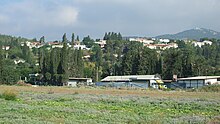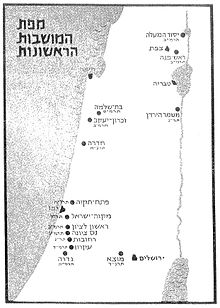Moshava
In a moshava, as opposed to later communal settlements like the kibbutz and the moshav (plural moshavim), all the land and property are privately owned.
[1] The economy of the early moshavot was based on agriculture and resembled the grain-growing villages of eastern Europe in layout.
[2] Petah Tikva, known as the "Mother of the Moshavot" (Em HaMoshavot),[3] was founded in 1878 by members of the Old Yishuv, as well as Gai Oni, which later became Rosh Pinna with the arrival of the First Aliyah.
The first four moshavot of the First Aliyah period were Rishon LeZion, Rosh Pinna, Zikhron Ya'akov and Yesud HaMa'ala.
Colonies were also established in the Hauran on lands bought by Baron Edmond de Rothschild in the area of the villages of Sahem al-Jawlan, Jileen and Nafa’a, by immigrants of the First Aliyah in a total of nine outposts, but the main five colonies, founded in 1895, had to be abandoned within a short while:[6][unreliable source?]





